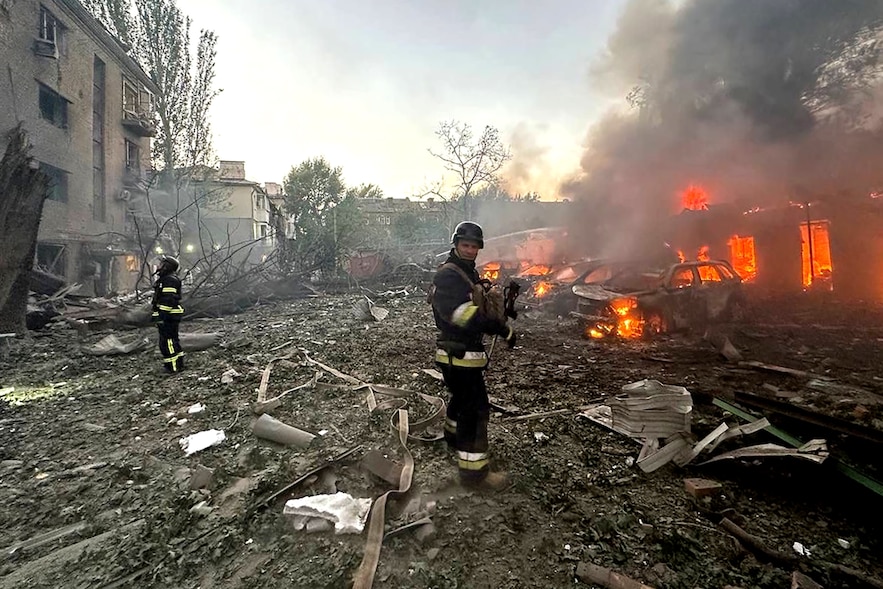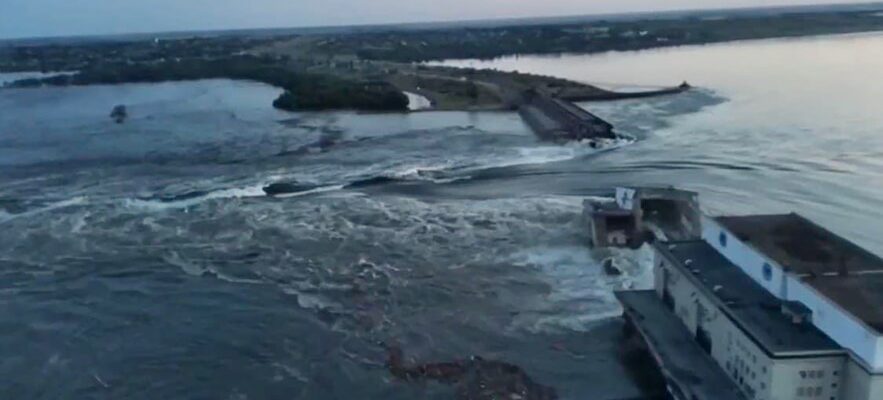Eleven days ahead of schedule, the Ukrainian operator Energoatom proudly announces the refurbishment of its last reactor, at the Rivne nuclear power plant, in the north-west of Ukraine. “We are ready. The repair program has been completed and all the units are loaded,” said Petro Kotin, the group’s president, interviewed by Ukrainian television on October 15. A few weeks earlier, on August 26, a wave of Russian strikes led to the disconnection of three of them. During this air attack – the most massive since the start of the conflict – Moscow launched a salvo of 236 missiles and drones across the four corners of the country against energy infrastructure, depriving more than 8 million people of electricity, including the inhabitants of kyiv. A breakdown of this magnitude has not been recorded in the Ukrainian capital since November 2022…
At a time when the thermometer begins to fall towards negative temperatures, a great fear is sweeping across the country today: reliving such a crisis in the heart of winter. “Our energy system is showing an unprecedented deficit at the start of the heating season,” attests Oksana Ishchuk, energy specialist and executive director of the Ukrainian institute Center for Global Studies Strategy XXI. The coming winter promises to be the more difficult since the start of the war.” For the third year in a row, Ukrainian authorities are expecting a new campaign of winter strikes, aimed at breaking the determination of its population by depriving them of heating. The previous two have already left the country’s energy infrastructure in a more than worrying situation.
Since 2022, Moscow’s massive attacks have left Ukraine with only about a third of its pre-war power generation capacity. According to a recent report by the International Atomic Energy Agency (IAEA), the occupation of the Zaporizhia nuclear power plant – the largest in Europe – by the Russians alone has deprived kyiv of around 6 gigawatts (GW, one gigawatt corresponds to the electricity needs of approximately 1 million people). And the strikes carried out by Moscow during 2024 caused it to lose an additional 9 GW. “The damage caused to infrastructure has dangerously accumulated over the last two years,” points out Benjamin Schmitt, senior researcher at the Kleinman Center for Energy Policy at the University of Pennsylvania and former advisor to the US State Department. At the dawn of third winter of the Russian invasion, we are faced with a potentially disastrous situation.”
Significant electricity deficit
In June, a study by the Kyiv School of Economics estimated the damage to Ukraine’s energy infrastructure at more than $16.1 billion, including more than $11.4 billion for electrical installations alone. The consequences have already been felt hard. During the summer, Ukraine experienced a significant electricity deficit with production capacities 2.3 GW lower than demand (12 GW), leading to power outages several hours a day in certain regions. The drop in temperatures during the winter months could further widen this gap. According to the IAEA, the deficit could this time reach up to 6 GW, the annual peak in electricity demand in a country like Denmark. And this, if current production capacities are not reduced by Moscow by then.
Far from bombing indiscriminately, the Russian army has evolved its strategy over the years. While in 2022 and 2023 the strikes mainly targeted the electricity distribution network, those in 2024 focused directly on production sites. At the end of May, around 70% of Ukraine’s thermal power plants – such as gas and coal – had been damaged or were occupied by Russian forces. Of the 36 strikes recorded since March by the United Nations, 25 have targeted thermal power plants. At the same time, attacks on hydroelectric power stations have tripled.
Photo released on June 6, 2023 by the Ukrainian operating company, Ukrgidroenergo, of the damaged Kakhovka hydroelectric dam, in the Kherson region
© / afp.com/Handout
This destruction of its conventional installations has increased Ukraine’s dependence on its three still operational nuclear power plants (Rivne, Khmelnytska, South Ukraine). “Nuclear energy today meets around 70% of electricity demand, underlines Haley Nelson, deputy director at the Global Energy Center of the Atlantic Council, in Washington. However, nuclear power plants need high-speed substations. voltage to distribute electricity to the network: if the latter were to be targeted, this would have serious repercussions because nuclear power plants adapt less easily than thermal power plants to fluctuations in electricity on the network.” Making these substations a prime target for the Kremlin and its campaign of terror.
During the massive attack on August 26, two of them were targeted. “If one of these systems is destroyed, it will take us several weeks to restore operations – and during that time we will face a huge electricity deficit, fears Oleksandr Kharchenko, general director of the Ukrainian Energy Industry Institute Research Center This is the most vulnerable part of our energy sector today.” If to protect this Achilles heel, Energoatom has launched the construction of concrete shelters for its Rivne power plant, the Ukrainian operator has recently been the target of criticism for having waited until the end of September before signing the contract of this construction site. In fact, it is not scheduled to expire until March 2025 – i.e. at the end of the winter heating period.
“People die in these situations”
Despite the immense efforts made by Ukrainian engineers to maintain the country’s energy installations, the balance of the system remains more than unstable. “We have no reserves,” continues Oleksandr Kharchenko. “If part of our electricity production capacity disappears, whether as a result of a technical incident or an attack, this will immediately result in restrictions energy for consumers.” European aid, with the 1.7 GW exported to the country, will not be enough to fill this gap. In September, a UN report indicated that power cuts could extend over periods ranging from 4 to 18 hours per day – at a time when temperatures sometimes approach -20 degrees.
Ukrainian cities, home to around 70% of the population, are particularly at risk. The reason is the high concentration of tall buildings inherited from the Soviet era, requiring an electrical supply to operate their elevators – essential for the elderly or people with reduced mobility – or the pump systems responsible for transporting water to the floors. the highest. Similarly, half of Ukrainian households rely on centralized heating, which again requires water and electricity to function. “Massive power cuts are synonymous with humanitarian crises: people die in these situations,” summarizes researcher Benjamin Schmitt. The danger also lies in the impact of these cuts on the functioning of services essential to society such as hospitals, the police, firefighters, or stores supplying the foodstuffs.” Ultimately, this possible deterioration of the energy situation could have serious consequences on the flow of refugees fleeing abroad each year. In a report published in August, the National Bank of Ukraine estimated that it could result in 700,000 additional departures between 2024 and 2025 – adding to the estimated 8 million people who have already left the country.

Rescuers at the site of a missile attack in Zaporizhia, Ukraine on September 29, 2024 – photograph taken and published by Ukrainian emergency services
© / afp.com/Handout
At the same time, targeting infrastructure is a good way for the Kremlin to paralyze Ukrainian economic activity. “Without electricity, no industry can function,” notes Oksana Ishchuk of the Center for Global Studies Strategy XXI. “Putin is trying to destroy the economy since he knows that it constitutes the main support of the front and the army.” More than two and a half years after the start of the war, Ukraine now devotes almost half of its national budget to defense – around $40 billion. At the beginning of October, Volodymyr Zelensky announced that during the first half of 2024, Ukraine had been able to produce “25 times more” artillery and mortar ammunition than during the entire year of 2022 and was today now able to manufacture 4 million drones per year. An energy shortage could significantly disrupt this war machine, and result in delays in deliveries essential to the defense of the front.
Despite Volodymyr Zelensky’s tireless appeals to his allies, kyiv still lacks anti-aircraft defenses to protect itself from Russian strikes. “Although Ukraine has made considerable progress in this area with the acquisition of efficient systems such as the Patriot, the SAMP-T or the IRIS-T, there remain gaps, confirms Haley Nelson of the Atlantic Council “Typically, Russia strikes simultaneously with large volumes of drones and missiles in order to overwhelm defenses, leaving many energy facilities – which are also scattered throughout the country – vulnerable.”
With winter approaching, the question of authorizing kyiv to use Western weapons to bomb air bases located in Russia – and used by Moscow for its strikes against Ukrainian infrastructure – could arise with even more force in the event of a widespread blackout. in the country. Because the Russian regime does not skimp on means. Following a new wave of attacks on Ukrainian cities on October 20, the Ukrainian president revealed that more than 6,100 drones had been launched against his country since the start of the year. And nearly 1,400 were in September alone. Winter promises to be yet another terrible ordeal for the population.
.
